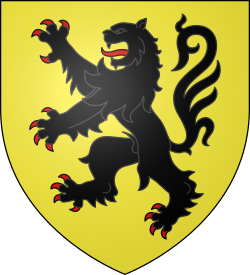History
In the Burgundian Netherlands, the States of Flanders were the first host of the States-General of the Netherlands, convened in Bruges on 9 January 1464.

In the history of the Low Countries, the Burgundian Netherlands were a number of Imperial and French fiefs ruled in personal union by the House of Valois-Burgundy in the period from 1384 to 1482 and later their Habsburg heirs. The area comprised large parts of present-day Belgium and the Netherlands, as well as Luxembourg and parts of northern France.
In 1579–1581, during the Eighty Years' War, the cities and the States of Flanders subscribed to the Union of Utrecht and the Act of Abjuration declaring independence from Habsburg rule, but royal troops reconquered most of the Flemish territory (excepting Zeelandic Flanders) and restored Habsburg rule.

The Eighty Years' War or Dutch War of Independence (1568–1648) was a revolt of the Seventeen Provinces of what are today the Netherlands, Belgium, and Luxembourg against Philip II of Spain, the sovereign of the Habsburg Netherlands. After the initial stages, Philip II deployed his armies and regained control over most of the rebelling provinces. Under the leadership of the exiled William the Silent, the northern provinces continued their resistance. They eventually were able to oust the Habsburg armies, and in 1581 they established the Republic of the Seven United Netherlands. The war continued in other areas, although the heartland of the republic was no longer threatened; this included the beginnings of the Dutch Colonial Empire, which at the time were conceived as carrying overseas the war with Spain. The Dutch Republic was recognized by Spain and the major European powers in 1609 at the start of the Twelve Years' Truce. Hostilities broke out again around 1619, as part of the broader Thirty Years' War. An end was reached in 1648 with the Peace of Münster, when the Dutch Republic was definitively recognised as an independent country no longer part of the Holy Roman Empire. The Peace of Münster is sometimes considered the beginning of the Dutch Golden Age.
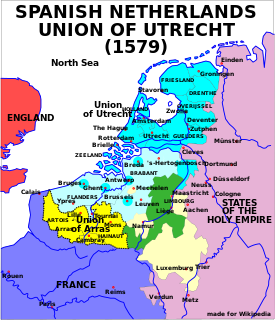
The Union of Utrecht was a treaty signed on 23 January 1579 in Utrecht, the Netherlands, unifying the northern provinces of the Netherlands, until then under the control of Habsburg Spain.

The Act of Abjuration is the declaration of independence by many of the provinces of the Netherlands from the allegiance to Philip II of Spain, during the Dutch Revolt.
Under the government of the Archdukes Albert and Isabella a representation of the First Estate was included in the composition of the States of Flanders.

Albert VII was the ruling Archduke of Austria for a few months in 1619 and, jointly with his wife, Isabella Clara Eugenia, sovereign of the Habsburg Netherlands between 1598 and 1621. Prior to this, he had been a cardinal, archbishop of Toledo, viceroy of Portugal and Governor General of the Habsburg Netherlands. He succeeded his brother Matthias as reigning archduke of Lower and Upper Austria, but abdicated in favor of Ferdinand II the same year, making it the shortest reign in Austrian history.

Isabella Clara Eugenia was sovereign of the Spanish Netherlands in the Low Countries and the north of modern France, together with her husband Albert VII, Archduke of Austria. In some sources, she is referred to as Clara Isabella Eugenia. By birth, she was an infanta of Spain and Portugal.
From 1754 smaller towns in Flanders were granted representation in the States, and the responsibilities of the body were extended from voting taxes and levying troops to oversight of public works and public assets.
On 4 January 1790, the States of Flanders declared independence from Austrian rule, and seven days later, on 11 January 1790, joined the United States of Belgium. All Southern Netherlands "States" disappeared four years later, during French revolutionary occupation.
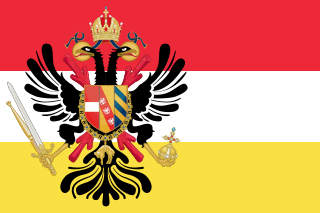
The Austrian Netherlands was the larger part of the Southern Netherlands between 1714 and 1797. The period began with the acquisition of the former Spanish Netherlands under the Treaty of Rastatt in 1714 and lasted until its annexation during the aftermath of the Battle of Sprimont in 1794 and the Peace of Basel in 1795. Austria, however, did not relinquish its claim over the province until 1797 in the Treaty of Campo Formio. The Austrian Netherlands was a noncontiguous territory that consisted of what is now western Belgium as well as greater Luxembourg, bisected by the Prince-Bishopric of Liège. The dominant languages were German, Dutch (Flemish), and French, along with Picard and Walloon.

The French Revolution was a period of far-reaching social and political upheaval in France and its colonies beginning in 1789. The Revolution overthrew the monarchy, established a republic, catalyzed violent periods of political turmoil, and finally culminated in a dictatorship under Napoleon who brought many of its principles to areas he conquered in Western Europe and beyond. Inspired by liberal and radical ideas, the Revolution profoundly altered the course of modern history, triggering the global decline of absolute monarchies while replacing them with republics and liberal democracies. Through the Revolutionary Wars, it unleashed a wave of global conflicts that extended from the Caribbean to the Middle East. Historians widely regard the Revolution as one of the most important events in human history.

Flanders is the Dutch-speaking northern portion of Belgium and one of the communities, regions and language areas of Belgium. However, there are several overlapping definitions, including ones related to culture, language, politics and history, and sometimes involving neighbouring countries. The demonym associated with Flanders is Fleming, while the corresponding adjective is Flemish. The official capital of Flanders is Brussels, although the Brussels Capital Region has an independent regional government, and the government of Flanders only oversees the community aspects of Flanders life in Brussels such as (Flemish) culture and education.
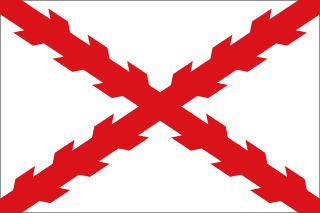
The Seventeen Provinces were the Imperial states of the Habsburg Netherlands in the 16th century. They roughly covered the Low Countries, i.e. what is now the Netherlands, Belgium, Luxembourg, and most of the French departments of Nord and Pas-de-Calais (Artois). Also within this area were semi-independent fiefdoms, mainly ecclesiastical ones, such as Liège, Cambrai and Stavelot-Malmedy.

The States General of the Netherlands is the bicameral legislature of the Netherlands consisting of the Senate and the House of Representatives. Both chambers meet at the Binnenhof in The Hague.

The Union of Arras was an alliance of a number of provinces in the southern part of the Habsburg Netherlands, who signed a declaration on 6 January 1579 about their intent to offer a vigorous defense of the Roman Catholic religion against what they saw as the encroachments of the Calvinists in other provinces. They started negotiations about a separate peace with the Spanish Crown in the Eighty Years' War which resulted in the Peace Treaty of Arras of 17 May 1579.

Louis II of Flanders, also known as Louis of Male, a member of the House of Dampierre, was Count of Flanders, Nevers and Rethel from 1346 as well as Count of Artois and Burgundy from 1382 until his death.

The United Belgian States, also known as the United States of Belgium, was a confederal republic in the Southern Netherlands which was established after the Brabant Revolution. It existed from January to December 1790 as part of the unsuccessful revolt against the Habsburg Emperor, Joseph II.
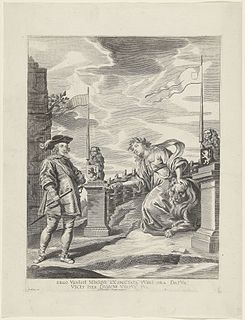
A Joyous Entry is the official name used for the ceremonial royal entry — the first official peaceable visit of a reigning monarch, prince, duke or governor into a city — mainly in the Duchy of Brabant or the County of Flanders and occasionally in France, Luxembourg or Hungary, usually coinciding with recognition by the monarch of the rights or privileges to the city, and sometimes accompanied by an extension of them.
Science and technology in Flanders, being the Flemish Community and more specifically the northern region of Belgium (Europe), is well developed with the presence of several universities and research institutes. These are strongly spread over all Flemish cities, from Kortrijk and Bruges in the Western side, over Ghent as a major university center alongside Antwerp, Brussels and Leuven to Hasselt and Diepenbeek in the Eastern side.

The Brabant Revolution or Brabantine Revolution, sometimes referred to as the Belgian Revolution of 1789–90 in older writing, was an armed insurrection that occurred in the Austrian Netherlands between October 1789 and December 1790. The revolution, which occurred at the same time as revolutions in France and Liège, led to the brief overthrow of Habsburg rule and the proclamation of a short-lived polity, the United Belgian States, through the unification of the region's federated states.

The Roman Catholic Diocese of Bruges, is a suffragan diocese in ecclesiastical province of the primatial Metropolitan archdiocese of Mechelen-Brussels.
Festival of Flanders is an annual music event at different locations in Flanders. It started initially as a "Summer Festival", but now its activities are spread from January to May, with a peak in late summer and early autumn.
Patricia Mary, Baroness Carson was an Anglo-Belgian historian and author.
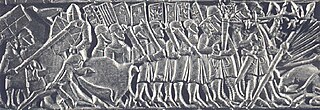
The Franco-Flemish War was a conflict between the Kingdom of France and the County of Flanders between 1297 and 1305.
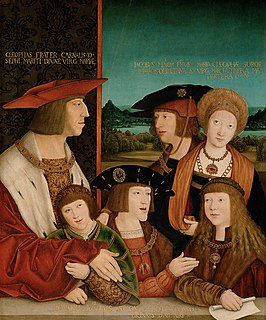
In the period 1482–1492, the cities of Flanders revolted twice against their Habsburg overlord, Archduke Maximilian of Austria. The revolts were rooted in the cities' desire to maintain the autonomy that they had wrested from his late wife, Mary the Rich of Burgundy, which Maximilian threatened to curtail. Both revolts were ultimately unsuccessful.

St. Trudo's Abbey, Bruges is a community of the Canonesses Regular of the Holy Sepulchre. It originated in Bruges in the 11th century, and between 1954 and 2013 was settled in Male Castle in Male, Sint-Kruis, Bruges, West Flanders, Belgium.

The Manifesto of the Province of Flanders was the declaration of independence of the county of Flanders on 4 January 1790, during the Brabantine Revolution. On this day, the States of Flanders "solemnly declare[d] in the name of the People, the province of Flanders to be an independent State, and definitively withdrawn from its loyalty and obedience to emperor Joseph II, count of Flanders, and from the House of Austria." The States also declared "all officials, lieges and other servants, whoever they may be, free and absolved from all concluded and indebted contracts, and discharged from every oath done to the fallen count of Flanders."
Philippe Joseph Jean Veranneman de Watervliet was a Southern Netherlands politician and magistrate. His more lasting reputation comes from his contribution to political and legal philosophy, notably as the author of the "Traité de la souveraineté" published in 1790.
